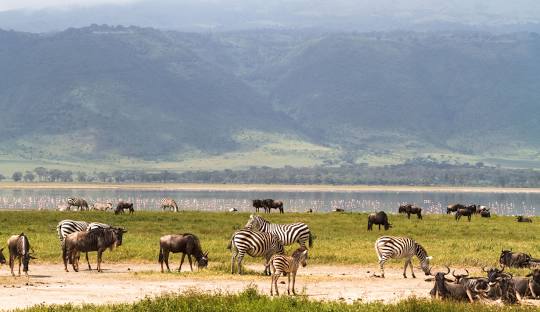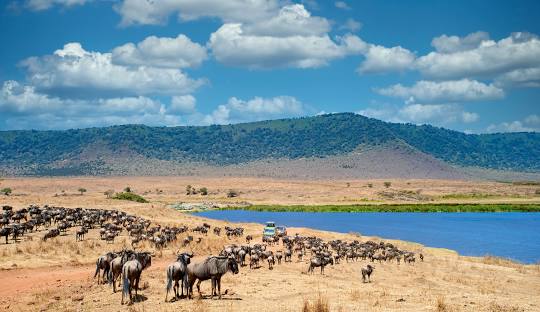
Ngorongoro Conservation Area
The Ngorongoro Conservation Area (NCA) is a UNESCO World Heritage site located in the northern part of Tanzania. It encompasses an area of approximately 8,292 square kilometers and is renowned for its striking geological features, rich biodiversity, and cultural heritage, this region is especially famous for the Ngorongoro crater, which is often portrayed as one of the natural wonders of the world. The Ngorongoro Crater is a massive volcanic caldera created approximately 2.5 million years ago when a large volcano exploded and collapsed in on itself. As one of the world’s largest intact calderas, it rises to around 2,200 meters above sea level and boasts steep walls that shelter a variety of ecosystems within. The crater floor is around 600m lower than the rim and covers about 260 square kilometers.
The diverse landscape of the Ngorongoro Conservation Area includes the lush highland forest at the rim of the crater, savannah grasslands, wetlands and alkaline lakes. This variety of habitats contributes to its rich biodiversity, which hosts not only a wide range of wildlife but also numerous bird species, the Ngorongoro Conservation Area is home to a unique ecosystem, the crater itself is populated by large density of herbivores including waterbucks, African leopards, black rhinos, buffaloes, cheetahs, crocodiles, East African wild dogs, elands, grant’s gazelle, zebra, hippopotamus, impala, lions, oribi, Thomson’s gazelles, Topi and wildebeest. Most of these animals remain in the natural enclosure without migrating except for a few wildebeest and elephants. This has led to significant inbreeding in some species like lions.
The area is also notable for its large array of birdlife housing over 500 species of birds including Flamingos, pelicans, heroes, ibises, ostriches, crown cranes, kori bustards, secretary birds, hammer kops, and European strain vultures
The Ngorongoro Conservation Area is not only a natural haven but also a cultural landscape. It is home to the Maasai people, a semi-nomadic pastoralist community renowned for their rich traditions and vibrant culture. The Maasai have coexisted alongside wildlife for centuries, practicing sustainable land management and livestock grazing. They play a vital role in the area‘s conservation efforts and tourism, preserving their cultural heritage while benefiting economically from the influx of visitors. the Maasai’s unique social structure, art, dance and ritual enrich the cultural tapestry of the region. Efforts are being made to harmonize conservation strategies with the traditional practices of the Maasai, acknowledging their role as stewards of the land.
Conservation Challenges.
Despite its designation as a conservation area, The Ngorongoro Conservation Area faces several challenges. The intersection of wildlife conservation and human habitation raises questions about resource management and land use. The increased human population in the surrounding area grows, the pressure on land resource pressure, can lead to encroachments into wildlife habitats, resulting in conflict between humans and wildlife, particularly with livestock. More so the increasing demand for land for agriculture and livestock grazing has escalated in recent years. The fertile areas on the crater rim are particularly foe agricultural expansion, although this can lead to habitat degradation bd fragmentation, impacting the movement and survival of wildlife.
Climate variability is becoming more pronounced, leading to altered rainfall patterns and temperature changes that effect both wildlife and human livelihoods. Prolonged droughts can impact water availability and food resources for both animals and humans, putting stress on the ecosystems, additionally, changes in climate can disrupt migratory patterns of wildlife, making it difficult for them to find adequate food and shelter.
While ecotourism is a major economic driver for the for Ngorongoro Conservation Area, it can also lead to environmental degradation if not mended sustainably. Overcrowding, pollution and waste management challenges are becoming more prominent as the number of visitors increases, balancing the benefits of truism with the need to promote the conservation area’s natural resources requires ongoing efforts and monitoring. Invasive species pose a threat to local ecosystems by outcompeting native flora and fauna. The introduction of non-native plants and animals can disrupt the balance of the habitats within the balance Ngorongoro Conservation Area, harming local biodiversity and ecosystem.

Despite conservation efforts, poaching remains a significant threat, especially to vulnerable species like black rhinos. The demand for wildlife products including horn, and skin continues to fuel the illegal wildlife trade, undermining conservation initiatives. Increasing infrastructural development in the area, such as roads and lodges/ settlements, can fragment critical habitat and create barriers to wildlife movement. As neighboring area develop, the risk of habitat loss grows, making it essential to balance developments with conservation priorities.
While the Maasai community has historically played a critical role in the conservation of the area, tension can rise regarding land rights and usage. Engaging local communities in conservation efforts and ensuring the derive tangible benefits from the preservation of wildlife and ecosystems is crucial for sustainable management. The Ngorongoro Conservation Authority has also ensured that the money collected from tourism benefits the local communities living within and close to the area. The Ngorongoro Conservation Authority also monitors changes in the lifestyle of the Maasai to ensure that it doesn’t have a negative impact on the area. There have also been restrictions and control of livestock movement within the conservation area.
Ecotourism in Ngorongoro Conservation Area
The Ngorongoro conservation area is one of the best places to view wildlife in Africa. It is also one of the most visited tourist attractions in Tanzania. The major tourism activities in the Ngorongoro Conservation Area include walking safaris to explore the hidden treasures of the area while observing wildlife from the rim of the crater, this amazing activity can last for about 6 hours, another thrilling activity is the game drive around and in the crater itself, camping along the rim of the crater as well as visiting the local Maasai villages. Other attractions include Olduvai Gorge, the Olmoti Crater, Ol Doinyo Lengai, Lake Magadi, the Shifting Sands, Ol Karien Gorge, the Gol Mountains, Oldeani Mountain, Lerai Fever Tree Forest, Salei Plains, the Empakaai Crater, Lake Natron, Nasera Rock and visiting the Hadzabe Tribe.
Lake Magadi is a shallow alkaline-filled lake in known for its high salinity, vibrant birdlife, particularly both lesser and greater flamingos and unique mineral formations. Other wildlife including pelicans, herons, fish, and invertebrates are also found around the lake.
The Shifting sands formed from volcanic ash and sand, these dunes shift with the winds, creating an ever-changing landscape. This ash moves slowly over the vast plains providing a great spectacle for tourists to happen to visiting the area. Apart from the Ngorongoro crater, the area has other large craters like the Olmoti and Empakaai. The Crater features a deep, turquoise lake surrounded by lush forest and steep walls, creating a habitat for various wildlife. Birdwatchers can spot Flamingos and other migratory birds while the surrounding trails offer superb hiking opportunities. The remote and pristine Gol Mountains are also a key attraction within the Ngorongoro Conservation area. It lies along a major route used by thousands of zebras and wildebeest as they migrate to and from the Serengeti plains.


